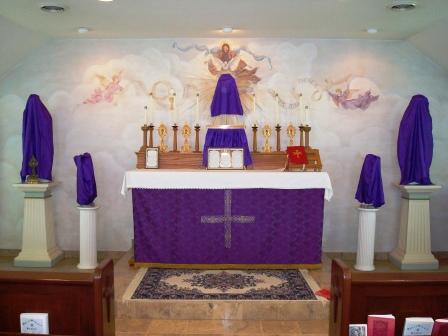
On the 5th Sunday of Lent we begin the period of the final two weeks of the season traditionally referred to as Passiontide. Crucifixes and other sacred images and statues are traditionally veiled during this time. We had never encountered this practice before until we moved to Texas. Other liturgical churches (e.g. Anglicans, Lutherans) also maintain this practice, although I understand that even there it isn't universal. What is the point of veiling? It is admittedly a good question - after all, why wouldn't one earnestly desire to gaze upon the Crucifix during this time? According to the 1917 Catholic Encyclopedia:
The crosses are veiled because Christ during this time no longer walked openly among the people, but hid himself. Hence in the papal chapel the veiling formerly took place at the words of the Gospel: "Jesus autem abscondebat se." Another reason is added by Durandus, namely that Christ's divinity was hidden when he arrived at the time of His suffering and death. The images of the saints also are covered because it would seem improper for the servants to appear when the Master himself is hidden.The crucifix is typically unveiled after the Lord's Passion is observed on Good Friday. Fr. Z reflects on this more:
We lose things during Lent. We are being pruned through the liturgy. Holy Church experiences liturgical death before the feast of the Resurrection. The Alleluia goes on Septuagesima. Music and flowers go on Ash Wednesday. Today, statues and images are draped in purple. That is why today is sometimes called Repus Sunday, from repositus analogous to absconditus or “hidden”, because this is the day when Crosses and other images in churches are veiled. The universal Church’s Ordo published by the Holy See has an indication that images can be veiled from this Sunday, the 5th of Lent. Traditionally Crosses may be covered until the end of the celebration of the Lord’s Passion on Good Friday and images, such as statues may be covered until the beginning of the Easter Vigil. At my home parish of St. Agnes in St. Paul, MN, the large statue of the Pietà is appropriately unveiled at the Good Friday service...Amen.
The pruning cuts more deeply as we march into the Triduum. After the Mass on Holy Thursday the Blessed Sacrament is removed from the main altar, which itself is stripped and bells are replaced with wooden noise makers. On Good Friday there isn’t even a Mass. At the beginning of the Vigil we are deprived of light itself! It is as if the Church herself were completely dead with the Lord in His tomb. This liturgical death of the Church reveals how Christ emptied Himself of His glory in order to save us from our sins and to teach us who we are.
The Church then gloriously springs to life again at the Vigil of Easter. In ancient times, the Vigil was celebrated in the depth of night. In the darkness a single spark would be struck from flint and spread into the flames. The flames spread through the whole Church.
If we can connect ourselves in heart and mind with the Church’s liturgy in which these sacred mysteries are re-presented, then by our active receptivity we become participants in the saving mysteries of Christ’s life, death and resurrection.
Stabat Mater dolorosa iuxta Crucem lacrimosa, dum pendebat Filius.
Cuius animam gementem, contristatam et dolentem pertransivit gladius.
No comments:
Post a Comment